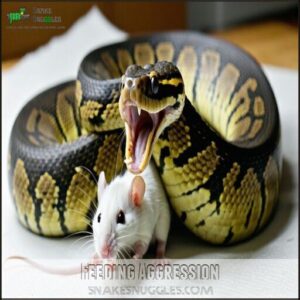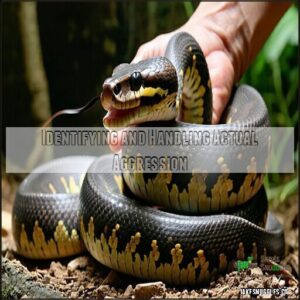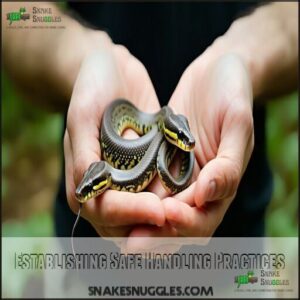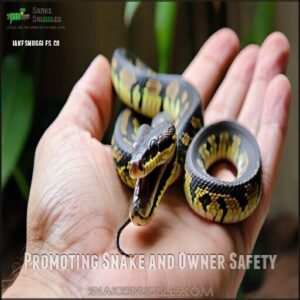This site is supported by our readers. We may earn a commission, at no cost to you, if you purchase through links.
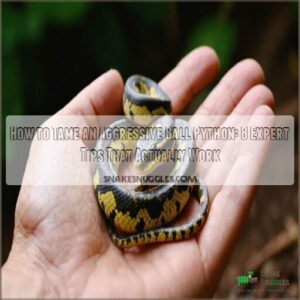
Create a calm environment and verify its habitat is appropriately sized, with proper temperature and humidity levels. Avoid sudden movements when handling, and use a snake hook if necessary to reduce stress.
Gradually introduce short handling sessions, letting the snake adjust at its own pace. Never handle after feeding or during shedding, as these are sensitive times.
Over time, your python will associate you with safety, not threat. Ready for more tips? Let’s explore handling techniques that build trust.
Table Of Contents
- Key Takeaways
- How to Tame an Aggressive Ball Python?
- Understanding Aggression in Ball Pythons
- Addressing Territorial and Feeding Aggression
- Identifying and Handling Actual Aggression
- Establishing Safe Handling Practices
- Promoting Snake and Owner Safety
- Assessing The Habitat for Stress Reduction
- Utilizing Tools for Aggression Management
- Seeking Professional Assistance When Needed
- Frequently Asked Questions (FAQs)
- How to tame a ball python?
- Why is my ball python behaving aggressively?
- How should you handle a ball python?
- Do ball pythons get frightened easily?
- How do you care for a ball python?
- Are ball pythons friendly?
- What to do if your ball python is aggressive?
- How do you get a ball python to stop biting you?
- Why is my ball python attacking me?
- How to tame a bitey snake?
- Conclusion
Key Takeaways
- Make sure your ball python’s enclosure has the right temperature, humidity, and hiding spots to reduce stress.
- Handle your snake gently and consistently, using a hook at first and avoiding sensitive times like after feeding or during shedding.
- Watch for defensive body language like hissing or coiling, and approach calmly to avoid triggering fear.
- Build trust gradually with short, regular handling sessions and a calm, predictable routine.
How to Tame an Aggressive Ball Python?
When approaching an aggressive ball python, patience forms the foundation of successful taming.
Start by optimizing your snake’s habitat with proper temperature gradients, humidity levels, and multiple secure hides to reduce stress triggers.
For defensive snakes, use a snake hook during initial handling sessions to maintain safe distance.
Never handle your ball python during feeding time, immediately after meals, or while shedding. Always support its entire body weight and avoid head restraints.
Through consistent interaction and gradual acclimation, you’ll build trust with your snake. Remember, positive reinforcement and predictable handling routines help transform aggressive behavior into calm confidence.
Understanding Aggression in Ball Pythons
Now that you’ve decided to tame your ball python, it’s essential to understand what’s really happening when your snake acts "aggressive".
What we call aggression in ball pythons isn’t hostility—it’s defensive behavior triggered by stress or fear. Your snake isn’t angry; it’s communicating discomfort through the only means it knows: hissing, striking, or coiling defensively.
Aggression in ball pythons is simply stress or fear in disguise—your snake is asking for safety, not picking a fight.
Ball pythons lack the brain development for malice. Their reactions stem from instinct, not calculated aggression. Environmental stressors like improper handling, habitat issues, or health problems often trigger these behaviors.
Some pythons may show more defensive tendencies due to genetic predisposition, but most can be tamed with patience and proper technique. Regular gentle handling can substantially reduce stress.
When approaching ball python taming:
- Create a low-stress environment with proper temperature, humidity, and hiding spots before attempting handling.
Remember, snake aggression isn’t personal—it’s a stress signal you can learn to recognize and address through consistent, gentle interaction and environmental improvements.
Addressing Territorial and Feeding Aggression
You can identify territorial and feeding aggression in ball pythons by observing their body language during specific situations such as approaching their enclosure or presenting food.
You’ll need different techniques to address each type of aggression, including proper feeding protocols and gradual desensitization through consistent handling routines.
Territorial Aggression
Understanding why your ball python defends its territory helps you address its aggressive behavior. When your snake strikes at the glass or becomes defensive as you approach, it’s displaying territorial aggression—a natural instinct, especially in younger snakes.
Territorial aggression in ball pythons is instinctive, often signaling stress or vulnerability, especially in younger snakes adjusting to their environment.
To reduce territorial behavior in your aggressive ball python:
- Create proper enclosure security with visual barriers on glass sides to help your snake feel less exposed
- Optimize hide placement with options on both warm and cool sides of the habitat
- Respect your python’s space needs by providing appropriate enclosure size and clutter
- Recognize potential scent marking behaviors and clean the enclosure regularly
Ball python taming requires consistency and patience. Most pythons outgrow territorial tendencies within their first year with regular, gentle handling. Snake aggression isn’t personal—it’s simply your python communicating that it feels vulnerable in its environment. A secure environment requires appropriate ball python hides. Remember that cage aggression often resolves with proper habitat setup and a consistent handling routine that builds trust over time.
Feeding Aggression
Why does your ball python suddenly lunge when mealtime approaches? Feeding aggression stems from natural hunting instincts rather than hostility.
To manage this behavior, establish pre-feeding cues like tapping with tongs to create scent association. Use appropriate food size to satisfy hunger completely.
Never handle your snake right before meals when it’s in hunting mode, as this triggers feed-response bites. After feeding, wait 48 hours minimum for proper digestion before handling.
Keep feeding schedules consistent, preferably at night when they naturally hunt. For owners with multiple snakes, separate feeding areas prevent competitive aggression.
Consistent routines help your ball python distinguish between feeding time and handling time. It’s also important to verify you’re thawing frozen prey correctly to avoid bacterial growth.
Cage Aggression
While feeding aggression focuses on meal-related behavior, cage aggression manifests when you approach your ball python’s habitat.
This territorial response occurs when your snake feels its personal space is being invaded.
Your python’s enclosure serves as both home and sanctuary.
Verify proper setup with appropriate hide placement on both the warm (88-92°F) and cool sides (75-85°F).
Environmental enrichment through strategically placed foliage creates security pathways for movement.
Space needs vary by age and size—too large an enclosure makes younger snakes feel vulnerable while insufficient space stresses adults.
Avoid reflective surfaces that create confusing visual stimuli.
When accessing the enclosure, move deliberately and use consistent approach patterns.
A snake hook can signal non-feeding interactions, reducing defensive behavior.
Stress reduction comes from respecting your python’s territory.
Regular, gentle handling sessions outside the enclosure help establish trust while maintaining clear boundaries between feeding time and social interaction.
A suitable habitat requires careful consideration of proper enclosure products.
Identifying and Handling Actual Aggression
You’ll need to distinguish between defensive reactions and true aggression in your ball python by observing specific behavioral patterns such as persistent striking without provocation or lunging with an open mouth.
You can effectively manage these behaviors through proper handling techniques including the use of a snake hook for initial contact and supporting the snake’s body fully while maintaining a confident demeanor.
Actual Aggression Causes
Most ball pythons aren’t actually aggressive—they’re defensive or stressed. When your typically calm pet suddenly shows aggression, several key factors are likely at play.
Environmental stressors often trigger defensive behavior:
- A snake hiding in corners or striking when you open the enclosure (inadequate security)
- Constant movement and inability to settle (temperature or humidity problems)
- Refusing to eat or regurgitating meals (stress-induced appetite issues)
Health issues can cause pain responses that manifest as aggression. Injuries, infections, or parasites may make your ball python lash out when touched. Nutritional deficits from irregular feeding schedules create desperate feeding responses.
Genetic predisposition plays a role too—some bloodlines are naturally more defensive. Females protecting eggs display instinctual behavior that resembles aggression.
During shedding, your ball python’s impaired vision increases vulnerability, making defensive reactions more likely. Understanding these causes is your first step toward effective ball python taming.
Tips for Handling Aggressive Behavior
Now that you understand what causes aggression, let’s tackle how to handle it effectively.
When faced with an aggressive ball python, proper technique makes all the difference.
- Watch body language carefully – S-shaped posture and rapid breathing indicate your snake feels threatened
- Maintain a calm demeanor – Your anxiety transfers directly to your ball python
- Master safe gripping techniques – Support the body’s weight without restricting movement
- Practice redirecting strikes – Use a hook to gently guide the head away from you
- Learn proper bite dislodging – If bitten, move toward the snake, not away, to release teeth
Remember that ball python taming isn’t accomplished overnight.
Consistency with these handling techniques will gradually transform your defensive serpent into a calm companion.
Patience yields remarkable results.
Establishing Safe Handling Practices
You’ll need to establish consistent handling methods that support your ball python’s entire body while minimizing stress signals.
Proper technique includes approaching from the side rather than above, using hooks when necessary, and maintaining short handling sessions of 10-15 minutes twice weekly to build trust gradually, which is crucial for building trust.
Handling Frequency and Safety
Proper handling frequency forms the cornerstone of ball python taming. Limit sessions to 5-10 minutes initially, gradually increasing as your snake shows comfort.
Maintain a schedule of just 1-2 handling sessions weekly to minimize stress. Always wash hands thoroughly before handling to remove food scents and prevent potential bites.
Move deliberately and provide proper support under your snake’s body—never grab the tail or restrict movement. Keep the python’s head away from your face during handling sessions.
For safety around children, guarantee strict adult supervision at all times. Use a snake hook for particularly defensive individuals until trust develops.
Remember that consistency matters more than duration—short, positive interactions build confidence faster than lengthy, stressful sessions. Patience ultimately transforms defensive behavior into calm acceptance.
Handling Hatchlings and Juveniles
Begin your hatchling’s handling journey with small, consistent sessions to build lasting trust. Young ball pythons naturally display defensive behaviors as a survival mechanism, requiring special attention during early handling.
Proper handling techniques are essential for hatchlings. Start with 5-minute sessions twice weekly, gradually increasing duration as the snake shows comfort. Support the entire body when lifting to prevent stress and potential injury. * Use a snake hook for gentle introduction, especially with more defensive individuals.
- Avoid handling during digestion (48 hours after feeding) or during the blue-eyed phase of shedding. Approach from the side rather than above to prevent triggering predator responses. Place your hands under the snake’s body rather than grabbing from above.
Gradual acclimation helps reduce hatchling temperament issues. Remember that building trust takes time—juvenile ball pythons need consistency and patience before they’ll develop comfort with human interaction.
Bite Prevention and Treatment
Bites from ball pythons, whether defensive or aggressive, happen.
Treat bites quickly to prevent infection.
Wash the area with soap and warm water.
Check for punctures, debris, or damage.
Disinfect using antiseptic, then apply antibiotic cream.
Watch for redness, swelling, or signs of worsening.
To prevent bites, avoid sudden movements, use handling tools like hooks, and recognize defensive cues like hissing.
If bitten, dislodge teeth gently by pushing toward the snake or using cold water.
A snake bite kit can help with treatment.
Have a snake bite kit handy.
Prevention is your best snake bite treatment strategy!
Promoting Snake and Owner Safety
Keeping both you and your ball python safe begins with understanding proper handling techniques and hygiene.
By focusing on precautions like avoiding potential bites and minimizing the risk of salmonella, you can create a secure environment for both of you, which involves proper handling techniques.
Salmonella Precautions
Salmonella precautions are essential for safe handling and preventing transmission. Ball pythons can carry bacteria like Salmonella without showing signs, so hygiene plays a key role in reptile health and snake bacteria control.
Wash your hands thoroughly both before and after handling your snake. This simple step minimizes risks for you and others, especially children’s safety.
Ensure your snake’s enclosure stays clean and sanitized. Regularly disinfect water bowls, hides, and other habitat items to maintain proper enclosure sanitation.
- Keep reptile care areas separate: Avoid cleaning snake equipment in kitchen sinks or other food prep zones.
- Teach children proper hygiene: Supervise interactions and remind them about handwashing importance after touching the snake or habitat.
Handling Techniques
Handling an aggressive ball python requires safe restraint and gradual acclimation.
Use both hands to support the body fully, ensuring slow, calm movements to minimize stress.
Tools like snake hooks or handling gloves can help avoid bites, especially with defensive behavior.
Focus on reading signals, such as hissing or coiling, to gauge ball python behavior.
Avoid jerky movements or letting the snake coil around your neck.
Here’s a quick guide:
| Priority | Action | Why It Matters |
|---|---|---|
| Safety First | Use hooks/gloves | Prevents accidental bites |
| Move Slowly | Avoid sudden actions | Reduces snake stress |
| Build Trust | Gradual, consistent handling | Encourages calm demeanor |
These handling techniques guarantee safety during snake handling while promoting stress reduction.
Assessing The Habitat for Stress Reduction
If your ball python seems aggressive, its habitat could be a source of stress. Ensuring proper temperature, humidity, and ample hiding spots can help create a secure, calming environment.
Appropriate Habitat
Creating the ideal environment for your ball python isn’t just thoughtful—it’s key to taming and stress reduction.
A proper enclosure fosters security and calm behavior.
- Temperature Gradient: Keep the warm side at 90–92°F and the cool side at 78°F. Heat lamps or under-tank heaters work well.
- Hiding Spots: Provide at least two snug hides—one on each side of the temperature zones—so the snake feels safe anywhere.
- Humidity Levels: Use cypress mulch or coconut fiber as your substrate choice to keep humidity at 50–60%.
A 40–60-gallon tank with enough space guarantees your python feels secure and adjusts more easily.
Stress Reduction
Stress often triggers defensive behavior in ball pythons, but the right environment minimizes snake stress. Focus on enclosure enrichment and consistency to promote relaxation.
- Provide secure hiding options like multiple snug hides to create safety.
- Keep temperatures consistent (88-92°F warm side, 76-80°F cool side) and maintain 70-80% humidity.
- Place the enclosure in a low-traffic area to avoid disruptions from noise or vibrations.
- Allow gradual acclimation by limiting handling initially.
A calm, consistent environment reduces snake stress factors, helping your python feel safe. These small changes substantially support snake stress reduction and foster long-term trust.
Utilizing Tools for Aggression Management
Using the right tools can make managing an aggressive ball python safer and more effective.
Items like a collapsible snake hook and a thermometer-humidity gauge help you handle with precision and maintain a calm, stress-free environment, which is crucial for effective management.
1. Deluxe Collapsible Snake Hook
Using a deluxe collapsible snake hook can make handling an aggressive ball python simpler and safer.
Its adjustable length, ranging from 7.25" to 26", offers enough space to keep a safe distance while managing the snake calmly.
Made from sturdy stainless steel, it provides durability during handling.
The ergonomic grip guarantees steady control, helping you practice effective snake taming and handling techniques with confidence.
The hook’s collapsibility benefits can’t be overstated—its pocket-sized design makes it portable and ready whenever needed.
Whether you’re managing cage adjustments or interacting with an aggressive ball python, this tool minimizes stress for both snake and handler.
For beginners, a snake hook is a practical tool for learning safe usage techniques.
While alternatives like handling gloves exist, a quality hook excels in reducing direct contact and maintaining safety during taming sessions.
2. Zoo Med Dual Thermometer Humidity Gauge
If you’re dealing with an aggressive ball python, a Zoo Med Dual Thermometer Humidity Gauge can be a game-changer.
It provides accurate readings of temperature and humidity, which are vital for managing ball python behavior and reducing stress. An unbalanced environment can make your snake defensive, but consistent monitoring creates a calm and comfortable habitat.
- Temperature Ranges: Keep the warm side at 88-92°F and the cool side around 78-80°F. Create a gradient so your snake can self-regulate.
- Humidity Monitoring: Maintain levels between 60-80%, especially during shedding, to avoid irritation.
- Gauge Calibration: Check your tools regularly to guarantee their readings are precise.
- Optimal Placement: Secure the gauge using Velcro in an easy-to-view spot for hassle-free adjustments.
A stable environment promotes relaxation and easier reptile handling. Understanding species-specific humidity needs is also key for their well-being. By prioritizing snake care and using proper tools, you’ll turn a defensive pet into a docile companion.
Seeking Professional Assistance When Needed
If your aggressive ball python isn’t responding to standard snake taming techniques, it might be time to seek professional assistance.
Persistent aggression or unusual snake behavior often signals deeper issues that require expert evaluation. A vet consultation with a reptile specialist can uncover hidden health problems, like infections or injuries, that may be driving the aggression.
- Tip: Breeders with expertise in snake behavior can also provide valuable insights into advanced handling or aggression management strategies.
For sudden behavioral changes or prolonged food refusal, immediate veterinary attention is essential. Respiratory infections or other illnesses can make your python defensive and stressed.
Be aware that unusual lethargy can also be a key indicator of illness. If aggression persists despite your efforts, a professional can recommend rehabilitation plans or, in rare cases, discuss rehoming options. Don’t hesitate—your python’s well-being and safety are worth the extra care.
Frequently Asked Questions (FAQs)
How to tame a ball python?
Start by ensuring the enclosure is stress-free with proper hides, temperatures, and humidity.
Handle gently, using a hook initially, and limit sessions to 10-20 minutes.
Gradually build trust by consistent, calm handling and observing behavior.
Why is my ball python behaving aggressively?
Your ball python might feel stressed, insecure, or defensive due to improper handling, hunger, shedding, or environmental issues like incorrect temperatures or lack of hides.
Identifying triggers and adjusting care can help reduce aggression.
How should you handle a ball python?
Handle your snake calmly and confidently.
Support its body fully, avoid sudden movements, and steer clear of its head.
Use a snake hook initially, then move to hands.
Limit handling to reduce stress and build trust.
Do ball pythons get frightened easily?
Yes, they do.
Sudden movements, loud noises, or unfamiliar environments can easily scare them.
Their survival instincts kick in when they feel threatened, often leading to defensive behaviors like hissing, striking, or curling into a ball.
How do you care for a ball python?
Provide a secure enclosure with proper temperatures, humidity, and hides.
Feed weekly, clean regularly, and minimize stress.
Handle gently, avoiding sudden movements, and monitor health closely, and adjust care as needed for a happy, healthy snake.
Are ball pythons friendly?
They can be calm and curious when properly cared for and handled gently.
Aggression usually stems from stress, fear, or poor conditions.
With patience and consistency, they often become docile and comfortable around you.
What to do if your ball python is aggressive?
Recognize signs like hissing or striking as stress signals.
Assess its enclosure for proper temperature, humidity, and hides.
Minimize handling temporarily, approach calmly, use a snake hook, and provide consistent care to reduce aggression.
How do you get a ball python to stop biting you?
Ironically, biting is often their way of saying, "I’m scared".
Handle them sparingly, avoid sudden movements, and guarantee proper enclosure conditions.
Use a hook initially, and let them gradually adjust to your presence over time, which helps them become comfortable, and reduces the likelihood of biting.
Why is my ball python attacking me?
Your ball python likely attacks due to fear, stress, or hunger.
It could feel threatened, experience pain, or struggle with environmental issues like improper temperatures or lack of hiding spots.
Observing behavior helps identify triggers.
How to tame a bitey snake?
Start by handling it gently with a hook, gradually shifting to hands.
Limit sessions to 10-15 minutes, twice weekly.
Make certain proper enclosure conditions, reduce stress, and allow it to acclimate before increasing interaction, ensuring a smooth process with minimal stress.
Conclusion
Did you know ball pythons are among the most popular pet snakes, yet aggression can make handling tricky?
By understanding their behavior and using proper techniques, you can learn how to tame an aggressive ball python effectively.
Focus on creating a stress-free habitat, handle with care during non-sensitive times, and use tools like a snake hook when needed.
Patience and consistency are key. Over time, your python will associate you with safety, building trust and reducing aggression.
- https://ball-pythons.net/forums/showthread.php?262357-How-do-u-tame-a-extremely-defensive-python
- https://reptifiles.com/ball-python-care-guide/ball-python-handling-tips/
- https://community.morphmarket.com/t/taming-a-super-food-agressive-ball/34588
- https://actavetscand.biomedcentral.com/articles/10.1186/1751-0147-53-33



